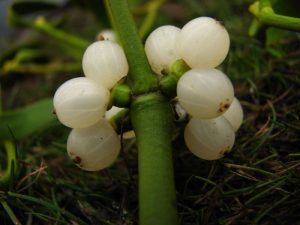Mistletoe, (Viscum album), has a place in British social history. The custom of kissing beneath the Mistletoe dates from a long forgotten fertility rite, possibly linked to the Druids who especially prized Mistletoe that was hosted on Oak trees. As Viscum album remains green throughout the year it was thought to maintain the life of deciduous trees through the winter months. The most common host is the orchard apple with Tilia and Crataegus also popular.
During the 1890’s a local botanist, William Paxton introduced Mistletoe to several locations in Edinburgh, notably the Dean Cemetery. Naturally spread by birds, the Mistle Thrush is the primary vector spreading the seed by defecating partially digested seed and the viscous jelly on host branches. Other birds spread the seed by beak wiping on host branches. The attached image of the white berry shows the strands of viscous gunge that conceals the individual seed. This stringing allows the seed to stick to a host branch. Germinating in spring a hooked hypocotyle locks into the bark surface. Gradually penetrating to the cambium layer it becomes parasitic linking into the xylem of the vascular system to obtain water and soluble nutrients. Through photosynthesis it converts sunlight into growth energy. It is thus not a true parasite but a hemiparasite.
Much of the Mistletoe sold in Britain originates from France where it is prolific. In November and December an annual Mistletoe auction takes place in Tenbury Wells, Worcestershire. Extracts from the plant are used in medicine and herbal remedies.
The inconspicuous flowers open during the winter and are pollinated by insects. The plant in the garden is growing on Aesculus flava and was introduced as seed from East Lothian in 2000. Viscum album is a dioecious plant and the one we grow is male.
Looking at the attached image the sturdiest parent stalk can be seen at the top of the Aesculus branch. There are two other stalks, one slightly less vigorous and another barely visible as a peg. Once established the mother plant sends these shoots up from subterranean haustorial strands and so the colony develops. Trees hosting colonies of Viscum album may show a loss of vigour and yield but rarely will an infestation kill the tree.

